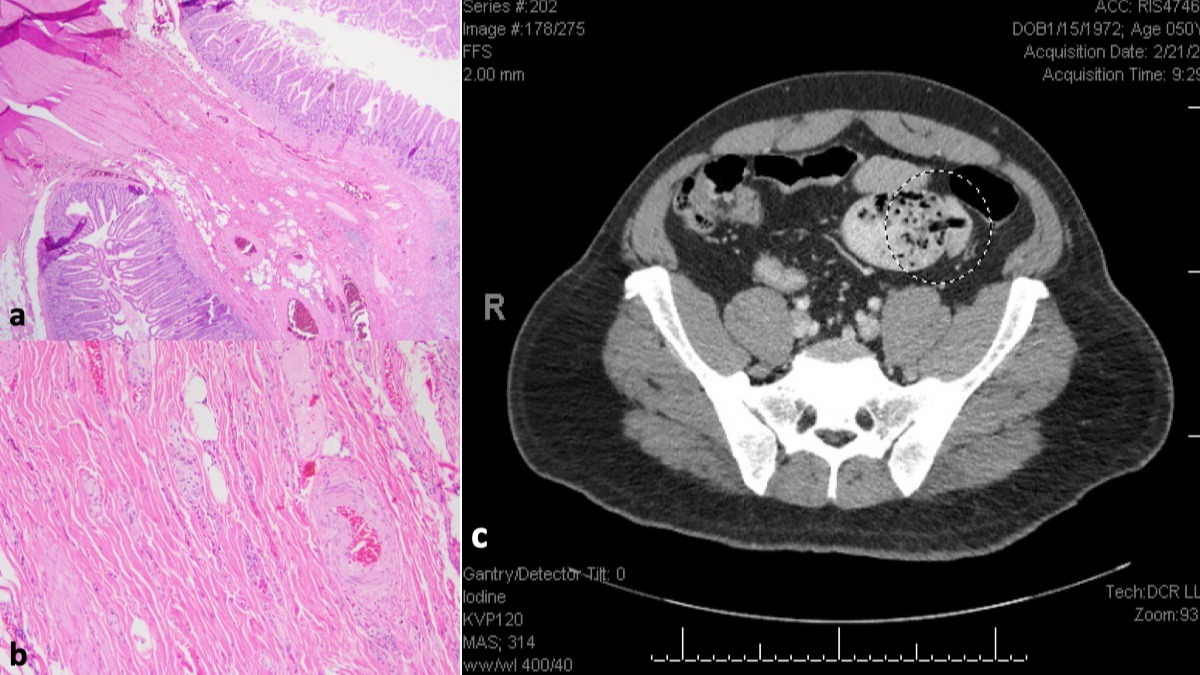Back


Poster Session C - Monday Afternoon
Category: Small Intestine
C0653 - Diaphragm Disease: A Crohn's Mimicker?
Monday, October 24, 2022
3:00 PM – 5:00 PM ET
Location: Crown Ballroom

Has Audio

Abigail Schubach, MD
University of Rochester Medical Center
Rochester, NY
Presenting Author(s)
Award: Presidential Poster Award
Abigail Schubach, MD, Natalie C. Penn, MD, Rabih Salloum, MD, Yanseng Hao, MD, PhD, Maisa Abdalla, MD, MPH
University of Rochester Medical Center, Rochester, NY
Introduction: Diaphragm disease of the small bowel is a rare disease typically associated with NSAID use. The disease is characterized by multiple strictures appearing as ‘pinhole’ sized lumens caused by mucosal thickening. Often the condition goes misdiagnosed until the lumen is visualized, with clinical presentations initially consisting of recurrent bowel obstructions, anemia and/or protein loosing enteropathy.
Case Description/Methods: A 50-year-old male with a history of hypertension, incarceration, and prior recurrent small bowel obstructions and prior exploratory laparotomy with lysis of adhesions, presented with recurrent abdominal pain, nausea, vomiting and constipation. A year prior to presentation, the patient was hospitalized for similar symptoms, with colonoscopy demonstrating a fibrotic stricture at the ileocecal valve, which was only able to be traversed after balloon dilation. The mucosa appeared endoscopically normal, however, biopsies of the terminal ileum demonstrated chronic active focal ileitis, suggestive of Crohn’s disease. The patient then experienced two more hospitalizations for small bowel obstruction, which resolved with supportive care and steroid administration. During this hospitalization, CT scan demonstrated a small bowel obstruction with several transition points in the mid small bowel. Intravenous corticosteroids were started, and nasogastric tube was placed with improvement. He adamantly denied any current or past prolonged NSAID use. It was decided that patient would benefit from a surgical small bowel exploration. Several strictures were seen in the proximal small bowel, and therefore proximal and distal resection of jejumum with a primary end-to-end enteroenterostomy anastomosis was performed. Histopathological evaluation of the resected specimen showed small bowel with circumferential membranes with submucosal neuromuscular and vascular hyperplasia, displaced mucosal glands, and associated mucosal active and chronic ileitis with ulceration, compatible with a diagnosis of diaphragm disease.
Discussion: NSAIDs can have deleterious effects on the small bowel including, ulceration, structuring, erosion formation, perforation and/or the formation of fibrous diaphragms that can lead to obstruction. Diaphragm disease is uncommon, especially in the absence of prior NSAID use. Clinically, it is important to recognize this group of patients as obstructive symptoms due to structuring/diaphragm disease are unlikely to resolve without some form of surgical intervention.

Disclosures:
Abigail Schubach, MD, Natalie C. Penn, MD, Rabih Salloum, MD, Yanseng Hao, MD, PhD, Maisa Abdalla, MD, MPH. C0653 - Diaphragm Disease: A Crohn's Mimicker?, ACG 2022 Annual Scientific Meeting Abstracts. Charlotte, NC: American College of Gastroenterology.
Abigail Schubach, MD, Natalie C. Penn, MD, Rabih Salloum, MD, Yanseng Hao, MD, PhD, Maisa Abdalla, MD, MPH
University of Rochester Medical Center, Rochester, NY
Introduction: Diaphragm disease of the small bowel is a rare disease typically associated with NSAID use. The disease is characterized by multiple strictures appearing as ‘pinhole’ sized lumens caused by mucosal thickening. Often the condition goes misdiagnosed until the lumen is visualized, with clinical presentations initially consisting of recurrent bowel obstructions, anemia and/or protein loosing enteropathy.
Case Description/Methods: A 50-year-old male with a history of hypertension, incarceration, and prior recurrent small bowel obstructions and prior exploratory laparotomy with lysis of adhesions, presented with recurrent abdominal pain, nausea, vomiting and constipation. A year prior to presentation, the patient was hospitalized for similar symptoms, with colonoscopy demonstrating a fibrotic stricture at the ileocecal valve, which was only able to be traversed after balloon dilation. The mucosa appeared endoscopically normal, however, biopsies of the terminal ileum demonstrated chronic active focal ileitis, suggestive of Crohn’s disease. The patient then experienced two more hospitalizations for small bowel obstruction, which resolved with supportive care and steroid administration. During this hospitalization, CT scan demonstrated a small bowel obstruction with several transition points in the mid small bowel. Intravenous corticosteroids were started, and nasogastric tube was placed with improvement. He adamantly denied any current or past prolonged NSAID use. It was decided that patient would benefit from a surgical small bowel exploration. Several strictures were seen in the proximal small bowel, and therefore proximal and distal resection of jejumum with a primary end-to-end enteroenterostomy anastomosis was performed. Histopathological evaluation of the resected specimen showed small bowel with circumferential membranes with submucosal neuromuscular and vascular hyperplasia, displaced mucosal glands, and associated mucosal active and chronic ileitis with ulceration, compatible with a diagnosis of diaphragm disease.
Discussion: NSAIDs can have deleterious effects on the small bowel including, ulceration, structuring, erosion formation, perforation and/or the formation of fibrous diaphragms that can lead to obstruction. Diaphragm disease is uncommon, especially in the absence of prior NSAID use. Clinically, it is important to recognize this group of patients as obstructive symptoms due to structuring/diaphragm disease are unlikely to resolve without some form of surgical intervention.

Figure: a + b) Submucosal fibrosis and neuromuscular and vascular hyperplasia. c) Focal narrowing and proximal dilation of a loop of small bowel with transition point within the mid small bowel.
Disclosures:
Abigail Schubach indicated no relevant financial relationships.
Natalie Penn indicated no relevant financial relationships.
Rabih Salloum indicated no relevant financial relationships.
Yanseng Hao indicated no relevant financial relationships.
Maisa Abdalla indicated no relevant financial relationships.
Abigail Schubach, MD, Natalie C. Penn, MD, Rabih Salloum, MD, Yanseng Hao, MD, PhD, Maisa Abdalla, MD, MPH. C0653 - Diaphragm Disease: A Crohn's Mimicker?, ACG 2022 Annual Scientific Meeting Abstracts. Charlotte, NC: American College of Gastroenterology.

